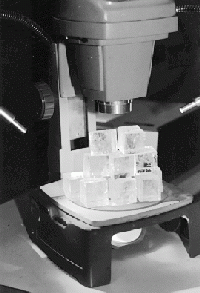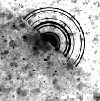SPI-Chem Sodium Chloride Rocksalt NaCl, 10 mm Cubes, CAS #7647-14-5, Pack of 5
Formula: NaCl
Appearance: Cubic clear (nearly transparent) crystals
Odor: None
CAS #: 7647-14-5
Density: 2.165 g/cm3
Description = 10mm cubes
These high quality research grade sodium chloride single crystal substrates offer a major advantage: the ability to grow epitaxial films on a featureless substrate.
The orientation of the film is related to the orientation of the substrate, producing areas of single crystal film. Sodium chloride has a cubic structure and cleaves along the (100) plane.
This feature is ideal for boundary diffusion studies and applications where a single crystal thin film is required. The film is easily removed by floating it off on water or by dissolving away the underlying substrate.
The micrograph shows a 30µm masked copper film grown epitaxial on a heated (300°C) single crystal NaCl substrate. The film was then overlaid with a 60µm film of aluminum. The single crystal diffraction pattern is from Cu9AI4 a compound formed at the boundary after annealing.
Bulk characterization of the single crystal substrate material has been performed, but only the most optically transparent material is selected. The major contaminant is CaSO4 with trace amounts of CaCl2, MgCl2, some "insoluble impurities" of unknown composition and moisture. The cubic shaped blocks are easily cleaved into smaller pieces as needed.
(Micrograph courtesy of John McCaffrey, National Research Council, Ottawa, Canada.)
These crystals are excellent for most research purposes and that is why we call them "research grade". However, these are not what one might call "semiconductor quality" which of course would be sold only at prices many times higher than these. The larger crystals are approximately 25mm cubes. The smaller crystals are approximately 10mm cubes.
Research Grade Single Crystal Blocks
Use only these crystals for fine research work requiring minimum 10 mm square uninterrupted areas.
Statement of purity:
Some of these rock salt crystals may have regions where a visible variation in transparency (haziness) is apparent. The most common visible defects, and the source of this haziness, are inclusions (i.e., air bubbles) that were incorporated into the crystals during crystal growth. This is a very difficult problem to eliminate without an enormous (and to most users, an unacceptable) increase in the cost of these crystals. To compensate for this cosmetic flaw, most crystals are supplied with a volume greater than listed (> 1 cm3 or > 1 in3) to allow the customer to find regions that are free of these (bubble) inclusions. All supplied crystals provide at least the volume of defect-free single crystal specified, and in most cases, a larger volume. Visual inspection is usually adequate to find regions of the crystals which are relatively free of these defects.
Chemical analysis:
NaCl 99.9%
CaSO4< 0.1%
CaCl2< 0.01%
MgCl2< 0.01%
Moisture< 0.01%
Historically, any concerns about "quality" usually result from appearance (visible small voids or crystalline defects) or from smell (sulfate released from voids when the crystals are cleaved.
Expected surface roughness:
A cleaved surface of the SPI single crystal NaCl cubes that is cleaved properly is atomically flat. However, most cleaved samples contain a series of cleavage steps. Here, the surface is atomically flat over an area, then steps up one or more atomic planes followed by another atomically flat area, etc.
Freshly cleaved surfaces:
Most experimental protocols calling for "freshly cleaved" sodium chloride crystals require that the crystals be cleaved on the spot by the researcher, not by us before shipment (the surface would be far from being "freshly cleaved").
Solubility in water:
A thin "wafer" that is 0.05" (1.27 mm) will dissolve in water at room temperature in roughly 30 seconds.
High temperature characteristics:
NaCl melts at 801° C (1474° F), so that obvious has to be the uppermost limit for use. Actually, the upper limit is lower than that, probably more like around 600° C (1112° F). We would expect that 600°C would be "safe", but this is not based on hard data. We would expect that any impurities that could be present in the crystals might off-gas before 600°C so if one is attempting such high temperature work, any loss of vacuum should not necessarily be interpreted that the upper limit at which this product could be used would have been breached.


